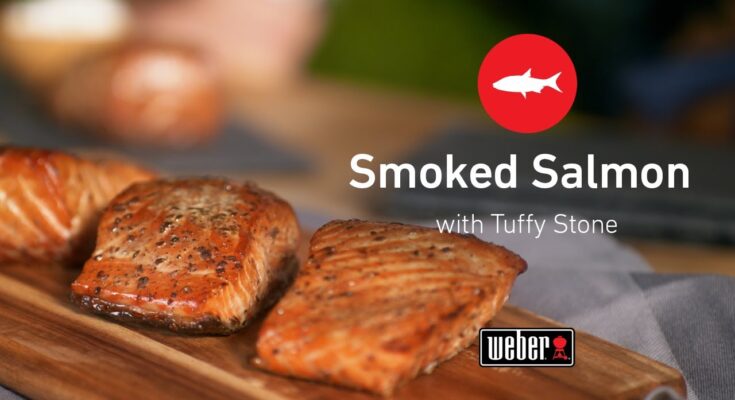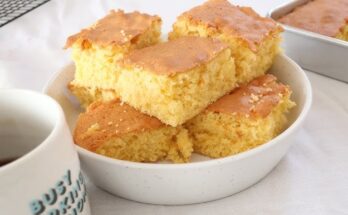Smoked Salmon Recipe: Nothing beats the rich, smoky flavor of homemade smoked salmon. It’s not only delicious and healthy, but it’s also incredibly rewarding to make from scratch.
In this guide, we’ll walk through the entire process—step-by-step—from selecting the perfect fish to enjoying your first bite of flavorful, smoky goodness.
Whether you’re using a backyard smoker or just starting with a small charcoal setup, this is the only guide you’ll need.
What Makes Smoked Salmon Special?
Smoked salmon is more than just a delicacy; it’s a culinary experience. With its silky texture and deep, savory flavor, it’s a star on breakfast plates, charcuterie boards, and even in pastas and salads. What sets smoked salmon apart is the combination of salt curing and the infusion of aromatic smoke, which enhances the natural richness of the fish. Unlike regular cooked salmon, smoked salmon undergoes a curing process that gives it a distinct, almost buttery texture and a long shelf life.
Another reason people love smoked salmon? It’s versatile. You can serve it chilled on bagels with cream cheese, pair it with eggs for brunch, or flake it into a creamy risotto. And let’s be real—nothing says “gourmet” quite like a homemade smoked salmon platter. Plus, making it yourself allows you to control the salt, the seasoning, the wood type, and the final texture.
Types of Smoked Salmon (Cold vs Hot Smoking)
Before diving into the smoking process, let’s break down the two main smoking techniques:
- Cold Smoking: This method involves smoking the salmon at a low temperature, usually below 90°F (32°C). The result is a silky, sashimi-like texture that’s not technically cooked. It requires a longer curing process and a bit more attention to food safety.
- Hot Smoking: This is done at higher temperatures—around 120°F to 180°F (49°C to 82°C)—which cooks the salmon while smoking it. The result is flaky, tender, and great for immediate eating or storing in the fridge.
Both methods produce delicious results, but for beginners, hot smoking is more forgiving and safer.
Choosing the Right Salmon
Best Salmon Varieties for Smoking
When it comes to smoking, not all salmon are created equal. The best varieties for smoking have a high-fat content, which helps them stay moist and flavorful during the smoking process. Here are a few top choices:
- King Salmon (Chinook): Rich, buttery, and loaded with healthy fats, this is the gold standard.
- Sockeye Salmon: Bright red flesh and bold flavor, perfect for a punchy smoked salmon.
- Atlantic Salmon: Often farm-raised, it’s fatty and consistent—ideal for hot smoking.
- Coho (Silver) Salmon: Milder in flavor but still great for smoking if you prefer something lighter.
Choose fillets that are firm, vibrant in color, and have a clean, fresh scent. Avoid anything that smells “fishy” or looks dull or gray.
How to Select Fresh Salmon
You don’t need to be a fishmonger to pick the perfect salmon. Here’s what to look for at the store or fish market:
- Color: Look for bright, even coloring—whether it’s deep red sockeye or pinker Atlantic.
- Smell: Fresh salmon should smell like the ocean, not ammonia or fish.
- Texture: It should feel firm to the touch, not mushy or slimy.
- Skin: If the skin is still on, it should be shiny and metallic-looking.
Buying from a reputable source or local fishmonger is a smart move. If you’re going frozen, opt for vacuum-sealed, flash-frozen fillets for the best quality.
Preparing Your Salmon
Cleaning and Filleting the Salmon
If you’ve bought a whole salmon, your first task is to clean and fillet it properly. Start by rinsing it under cold water to remove any loose scales or residue. Then, using a sharp fillet knife:
- Make an incision behind the gills down to the backbone.
- Run your knife along the backbone toward the tail, carefully separating the fillet.
- Flip and repeat on the other side.
- Remove pin bones using a pair of tweezers—feel for them with your fingers.
- Rinse again and pat dry.
You can skip this step if you buy pre-cut fillets, but doing it yourself gives you a greater sense of accomplishment and ensures freshness.
Trimming and Portioning the Fish
Once filleted, it’s time to trim and portion your salmon. Trim away the belly fat if you want a leaner bite or leave it on for more richness. Then, cut the fillet into even pieces—about 4 to 6 inches long—for easier curing and smoking.
Uniform sizes help ensure that all pieces cure and smoke evenly. If you’re aiming for smoked salmon for bagels or platters, slice thinner pieces. For flakier, hot-smoked bites, slightly thicker chunks are perfect.
The Brining Process
Why Brining is Essential
Brining isn’t optional—it’s a crucial step that seasons your fish and improves texture. Brining does three things:
- Draws out moisture: This firms up the flesh.
- Adds flavor: Salt, sugar, and spices penetrate the meat.
- Preserves the fish: Essential for cold smoking and longer storage.
It’s like marinating but way more important. Think of it as the salmon’s spa day—salt soak, rest, and ready to glow!
Dry Brine vs Wet Brine: Which One to Use?
There are two main ways to brine:
- Dry Brine: A mixture of salt and sugar (sometimes spices) is rubbed directly onto the salmon. It’s simple, effective, and perfect for a firmer texture.
- Wet Brine: Salmon is soaked in a salty, sugary liquid mixture. It’s a gentler approach that adds moisture.
Basic Dry Brine Recipe:
- 1 cup kosher salt
- 1 cup brown sugar
- Optional: black pepper, dill, garlic powder
Basic Wet Brine Recipe:
- 1 quart water
- 1/3 cup kosher salt
- 1/3 cup sugar
- Spices to taste
For beginners, a dry brine is easier to manage and works great for both hot and cold smoking.
Brining Time and Tips
Brine time depends on thickness and your desired saltiness. Here’s a quick guide:
- Thin fillets: 4 to 6 hours
- Thick fillets or whole sides: 8 to 12 hours
After brining, rinse the fish under cold water to remove excess salt, then pat it completely dry. Let it rest uncovered in the fridge for a few hours to develop a pellicle—a tacky surface that helps smoke adhere better.
Smoking the Salmon
Setting Up Your Smoker
Now that your salmon is brined and ready, it’s time to fire up the smoker. Whether you’re using an electric smoker, charcoal grill, or pellet smoker, the key is maintaining consistent low heat and good airflow.
Here’s how to set up for hot smoking:
- Preheat your smoker to 160°F to 180°F (71°C to 82°C).
- Add your wood chips—soaked for at least 30 minutes if using a charcoal or gas setup.
- Arrange the salmon on a rack with space between each piece to let the smoke circulate.
- Use a water pan to maintain moisture if your smoker tends to dry out.
- Monitor the temperature closely with a thermometer. Fluctuations can mess with texture.
For cold smoking, you’ll need a cold smoke generator and to keep the temperature below 90°F (32°C). This setup is trickier and requires more attention to food safety, so it’s better for more experienced smokers.
Tip: Don’t overcrowd the smoker. Give your salmon room to breathe (and smoke!).
Wood Chips: Best Types for Flavor
Choosing the right wood is crucial—it’s like picking the seasoning for your smoke. Each wood type brings its own flavor profile, and some pair better with fish than others.
Here are the best woods for smoking salmon:
- Alder: Classic choice, especially in the Pacific Northwest. It’s light, slightly sweet, and complements salmon perfectly.
- Applewood: Sweet and fruity, gives a mellow flavor. Great for those who like a milder smoked taste.
- Cherry: Slightly stronger than apple, adds color and depth.
- Maple: Subtly sweet and smooth, pairs well with brown sugar brines.
- Hickory: Bold and smoky, but use sparingly—it can overpower delicate salmon.
Avoid mesquite—it’s too strong and can make your fish bitter. You can also experiment by blending woods (like alder and apple) for a custom flavor profile.
Ideal Smoking Temperature and Time
Time and temperature are everything when smoking salmon. Get them wrong, and you’ll either undercook or dry out your fish.
Hot Smoking Guidelines:
- Temperature: 160°F to 180°F (71°C to 82°C)
- Time: 2 to 4 hours depending on thickness
- Internal Temp Goal: 145°F (63°C) in the thickest part
Cold Smoking Guidelines:
- Temperature: Below 90°F (32°C)
- Time: 12 to 24 hours or more
- Requires full cure beforehand
Check your salmon periodically. The outside should turn a rich golden or copper hue, and the flesh should flake easily with a fork. For a deeper flavor, consider starting at a lower temp (around 120°F) and gradually increasing to 180°F over time.
Remember: patience pays off. The longer the salmon smokes (without drying out), the more intense and satisfying the flavor.
Finishing and Storing Your Smoked Salmon
Cooling and Resting the Salmon
Once the smoking is done and your salmon reaches that perfect internal temp of 145°F (63°C), resist the urge to dig in right away. Let the salmon cool down at room temperature for about 30 minutes. This resting period helps the juices redistribute and the texture to settle—kind of like letting a steak rest after grilling.
After resting, move the salmon to a plate or rack and refrigerate it uncovered for another hour or two. This cooling phase tightens the flesh slightly and enhances the final flavor, especially if you’re aiming for that classic smoked-salmon chewiness.
If you’re cold-smoking, make sure to refrigerate it immediately after the smoke is done. You can also freeze portions for longer storage without sacrificing taste or texture.
How to Store Smoked Salmon Properly
To keep your smoked salmon tasting fresh and safe to eat, proper storage is a must. Here’s how to do it right:
- Short-term: Wrap the smoked salmon tightly in plastic wrap or vacuum-seal it, then store it in the refrigerator. It’ll last for up to 7–10 days.
- Long-term: For longer storage, vacuum-seal the pieces and freeze them. They’ll keep for up to 3 months without losing much quality.
- Pro Tip: Label your packages with the smoking date. This makes it easy to rotate stock and enjoy your oldest batches first.
Avoid storing it unwrapped in the fridge—it will dry out quickly and absorb other odors. Trust me, no one wants salmon that tastes like last night’s takeout.
Serving Suggestions for Smoked Salmon
Simple Ways to Serve Smoked Salmon
You’ve worked hard for that delicious, smoky goodness—now it’s time to enjoy it. There are countless ways to serve smoked salmon, but here are some tried-and-true favorites:
- On a Bagel: Classic combo with cream cheese, capers, red onion, and fresh dill.
- On Toast: Avocado toast with a slice of smoked salmon on top? Total brunch vibes.
- With Eggs: Toss it in scrambled eggs or layer on top of an eggs benedict for an upscale twist.
- Salads: Flake it into a Caesar or spinach salad for a burst of protein and flavor.
- Appetizers: Wrap it around cream cheese-stuffed cucumbers or roll into pinwheels with tortillas.
For a gourmet platter, arrange smoked salmon with crackers, brie or goat cheese, olives, lemon wedges, and a drizzle of honey mustard or horseradish sauce. Your guests will think you hired a caterer.
Creative Recipes Using Smoked Salmon
Want to level up your kitchen game? Try using your smoked salmon in some unexpected dishes:
- Smoked Salmon Pasta: Combine with cream, garlic, lemon, and fresh herbs for a restaurant-worthy dinner.
- Smoked Salmon Quiche: Mix into an egg and cheese quiche for a rich, savory brunch.
- Smoked Salmon Sushi Rolls: Slice into strips and roll with rice, avocado, and cucumber.
- Smoked Salmon Pizza: Add it on top of a white pizza with capers, arugula, and a drizzle of olive oil.
The sky’s the limit. Once you have a batch of smoked salmon on hand, you’ll find ways to use it in everything from sandwiches to canapés.
Health Benefits of Smoked Salmon
Nutritional Value and Benefits
Aside from being mouth-wateringly delicious, smoked salmon is also packed with nutrients. It’s rich in omega-3 fatty acids, which are great for heart health, brain function, and reducing inflammation. A typical 3-ounce serving has around:
- 180 calories
- 22g of protein
- 10g of fat (mostly healthy unsaturated fats)
- Zero carbs
It’s also a great source of:
- Vitamin B12
- Vitamin D
- Selenium
- Niacin
Just keep in mind that smoked salmon can be high in sodium due to the brining process. So, if you’re watching your salt intake, enjoy it in moderation or opt for a lighter brine when making it at home.
Common Mistakes to Avoid When Smoking Salmon
What Can Go Wrong and How to Prevent It
Even seasoned grill masters slip up now and then. Here are some common mistakes to avoid during your salmon smoking journey:
- Skipping the pellicle step: That tacky layer formed after brining helps smoke stick. Don’t skip the air-dry.
- Too much heat: High heat will cook the salmon too fast, drying it out and ruining the texture.
- Over-smoking: More smoke doesn’t always mean more flavor. Stick to a few hours and mild woods.
- Uneven cuts: Different thicknesses smoke at different rates. Try to portion your fillets evenly.
- Under-brining or over-brining: Get the timing right or you’ll end up with either bland or overly salty fish.
Want perfect smoked salmon every time? Follow the steps carefully, take your time, and taste as you go. Practice makes perfect—and delicious.
FAQs about Smoked Salmon Recipe
1. What type of salmon is best for smoking?
For smoking, it’s ideal to use fatty salmon like King or Sockeye, which have high oil content that keeps the fish moist during the smoking process. Atlantic salmon is also a popular choice due to its availability and consistent quality.
2. How long does it take to smoke salmon?
The smoking time can vary depending on the thickness of the fillets and the temperature of your smoker. Generally, it takes about 3 to 4 hours at 225 degrees Fahrenheit to properly smoke salmon until it’s perfectly tender and flaky.
3. Do I need to brine salmon before smoking?
Yes, brining is a critical step. A basic brine with salt, sugar, and water helps to enhance the salmon’s flavor, retain moisture, and give the fish a firmer texture. Brining for 4 to 6 hours, or even overnight, is recommended for the best results.
4. Can I use a rub or seasoning on smoked salmon?
Absolutely! You can customize your smoked salmon with various rubs or seasonings. Common additions include dill, garlic, brown sugar, or even a touch of cayenne for heat. Apply the seasoning evenly before smoking to infuse the salmon with extra flavors.
5. Is it necessary to use wood chips, and what kind are best?
Wood chips are essential for adding that distinctive smoky flavor. Alder wood is traditionally used for salmon due to its mild, slightly sweet flavor. Other great options include apple, cherry, or hickory for a deeper smoke taste.
6. How do I store smoked salmon, and how long will it last?
Smoked salmon can be stored in the refrigerator for up to one week if it’s wrapped tightly in plastic wrap or foil. For longer storage, you can freeze the smoked salmon for up to three months. Always thaw it in the refrigerator before use.
7. Can smoked salmon be eaten raw?
Smoked salmon is not raw; it is cured and partially cooked by the smoking process, making it safe and ready to eat. It’s perfect as is for salads, paired with cream cheese on bagels, or as a flavorful addition to pasta dishes.
Conclusion
Smoking your own salmon at home isn’t just about the flavor—it’s about the process. From choosing the freshest fish to setting up your smoker and nailing the brine, it’s a culinary adventure that pays off big time. Whether you’re serving it on a bagel or as a showstopper at dinner, homemade smoked salmon brings a sense of pride (and some serious flavor) to your table.
With this guide in hand, you’re all set to dive into the world of smoking. Once you master the basics, there’s so much room for creativity—try different woods, seasonings, and techniques until you find your signature smoked salmon style.



